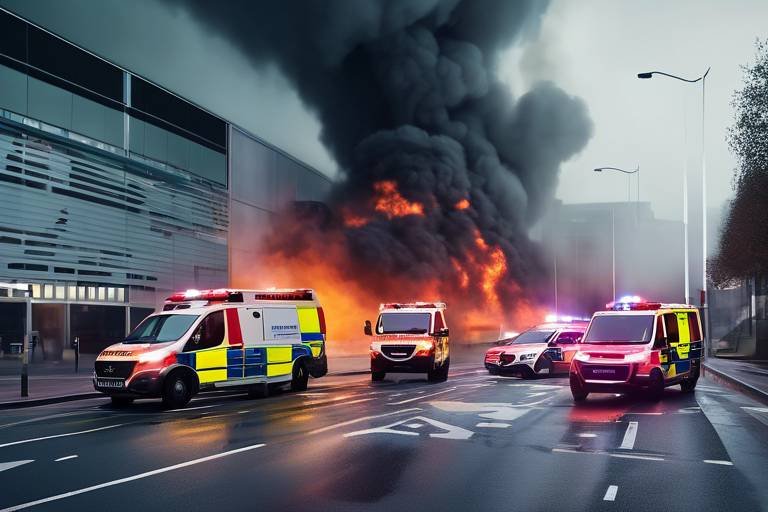Transforming Modern Emergency Services with AI
The landscape of emergency services is undergoing a **remarkable transformation**, thanks to the integration of artificial intelligence (AI). Imagine a world where emergency responders can predict incidents before they occur, allocate resources with pinpoint accuracy, and provide faster medical assistance—all made possible through the power of AI. This isn’t just a futuristic dream; it’s happening now. The advent of AI technologies is reshaping how we respond to emergencies, making services more efficient and effective, and ultimately saving lives.
At the heart of this transformation lies a suite of advanced tools and techniques that enhance the capabilities of emergency personnel. From AI-powered dispatch systems that optimize response times to predictive analytics that forecast potential emergencies, the benefits are profound. These innovations not only improve the speed of response but also ensure that the right resources are deployed at the right time. As we delve deeper into this article, we will explore the various applications of AI in emergency services, the challenges faced, and the exciting future that awaits.
One of the most significant advancements in emergency services is the development of AI-powered dispatch systems. These systems are designed to enhance the efficiency of emergency response by analyzing vast amounts of data in real time. By optimizing response times, predicting incident hotspots, and improving resource allocation, AI is revolutionizing how dispatchers operate. Picture this: a system that can analyze traffic patterns, weather conditions, and historical incident data to determine the fastest route for an ambulance. This capability can mean the difference between life and death.
Moreover, AI can help identify trends and patterns in emergency incidents, allowing dispatchers to anticipate where resources will be needed most. For instance, if a particular area has seen a spike in accidents during certain hours, AI can alert dispatchers to allocate more ambulances to that region during peak times. This proactive approach not only enhances response times but also ensures that emergency services are prepared for potential crises before they unfold.
Another groundbreaking aspect of AI in emergency services is the use of predictive analytics. By harnessing historical data, emergency management teams can forecast potential emergencies, enabling them to take proactive measures. Imagine being able to predict the likelihood of a natural disaster or a public health crisis before it happens. This capability allows for better preparedness and resource management in times of crisis.
Integrating real-time data from various sources is critical for effective emergency response. With AI, emergency services can access and analyze data from traffic cameras, weather reports, and even social media platforms. This integration improves situational awareness, allowing responders to make informed decisions quickly. For example, if a severe storm is approaching, AI can aggregate data to alert emergency teams to prepare for potential flooding or evacuations.
Geospatial analysis is another powerful tool in the AI arsenal. By visualizing incidents on maps, emergency responders can strategize their responses based on location data. This capability is particularly useful in urban settings where navigating through traffic can be challenging. With geospatial analysis, responders can identify the quickest routes and even anticipate potential obstacles, ensuring that they reach those in need as quickly as possible.
In today’s digital age, social media has become a vital source of information during emergencies. Monitoring these platforms provides valuable insights into public sentiment and emerging emergencies. AI can sift through vast amounts of social media data to identify trends and reports of incidents, allowing responders to act promptly. For instance, if a large crowd gathers at a location due to an unexpected event, AI can alert emergency services to prepare for potential safety issues.
AI-assisted triage systems are revolutionizing how medical emergencies are handled. These systems evaluate patient conditions rapidly, ensuring that the most critical cases receive immediate attention. Imagine a scenario where multiple patients arrive at a hospital following an accident. AI can quickly assess their conditions based on vital signs and medical history, optimizing care delivery during emergencies. This not only improves patient outcomes but also alleviates the pressure on medical staff.
Training is crucial for emergency personnel, and AI-driven simulations provide realistic environments for practice. These enhancements improve preparedness and decision-making skills under pressure. With AI, training modules can adapt to the trainee’s performance, providing tailored experiences that challenge and develop their skills.
Virtual reality (VR) training modules offer immersive experiences, allowing emergency responders to practice scenarios safely and effectively. Imagine a firefighter training in a virtual burning building, gaining experience without the associated risks. This kind of training not only builds confidence but also ensures that responders are better prepared for real-life situations.
AI feedback systems analyze past responses to refine training programs. By reviewing what worked and what didn’t, emergency personnel can continuously improve their skills and approaches. This commitment to learning and adaptation is crucial in a field where every second counts.
The future of AI in emergency services promises even greater advancements. With ongoing research and development, we can expect even more sophisticated tools that enhance response capabilities and save lives. The integration of AI will continue to evolve, offering new solutions to age-old challenges faced by emergency responders.
- How is AI currently being used in emergency services? AI is used for dispatch optimization, predictive analytics, medical triage, and training simulations.
- What are the benefits of using AI in emergency response? AI improves response times, enhances situational awareness, optimizes resource allocation, and increases overall efficiency.
- Can AI predict emergencies? Yes, through predictive analytics, AI can analyze historical data to forecast potential emergencies and help in proactive planning.
- What role does social media play in emergency management? Social media monitoring provides real-time insights into public sentiment and emerging incidents, allowing for timely responses.

AI-Powered Dispatch Systems
The integration of artificial intelligence (AI) into dispatch systems is nothing short of a game-changer for emergency services. Imagine a world where every second counts, and the ability to respond swiftly can mean the difference between life and death. AI is revolutionizing how dispatchers operate, enabling them to optimize response times, predict incident hotspots, and allocate resources more effectively than ever before. This is not just about technology; it’s about saving lives and enhancing public safety.
One of the most significant advancements in AI-powered dispatch systems is the ability to analyze vast amounts of data in real-time. This means that dispatchers can receive alerts about potential emergencies before they even occur. By leveraging historical data and current trends, AI can predict where incidents are likely to happen. For example, if a certain area has seen a spike in traffic accidents during a particular time of day, the system can preemptively allocate more resources to that location. As a result, emergency responders can be on the scene much faster, reducing response times significantly.
Furthermore, AI enhances resource allocation by evaluating the availability of emergency personnel and equipment. It can assess which units are closest to an incident and can respond the quickest. This capability is crucial in urban settings where traffic congestion can delay response times. By using geospatial analysis, AI can map out the quickest routes for emergency vehicles, ensuring they arrive at the scene without unnecessary delays. The efficiency gained through these systems can ultimately lead to better outcomes for those in need of urgent assistance.
Additionally, AI-powered dispatch systems can also facilitate better communication among various emergency services. Whether it’s police, fire, or medical teams, these systems can ensure that everyone is on the same page. For instance, during a multi-agency response to a major incident, AI can streamline communication, allowing for a coordinated effort that maximizes the effectiveness of the response. This is particularly vital in chaotic situations where clear communication can be challenging.
In summary, AI-powered dispatch systems are transforming emergency response capabilities, making them faster, smarter, and more efficient. As technology continues to advance, we can expect these systems to evolve further, incorporating even more sophisticated algorithms and data sources. The future of emergency services is bright, and AI is at the forefront of this transformation, paving the way for a safer society.

Predictive Analytics in Emergency Management
In today's fast-paced world, emergencies can strike at any moment, and being prepared is crucial. This is where predictive analytics comes into play, revolutionizing how emergency management operates. By harnessing the power of historical data, predictive analytics allows emergency services to forecast potential emergencies and take proactive measures, which leads to better preparedness and resource management during crises. Imagine being able to predict a storm before it hits or anticipating a spike in medical emergencies during a public event. With predictive analytics, these scenarios are not just possible; they are becoming a reality.
One of the key benefits of predictive analytics is its ability to analyze vast amounts of data quickly. Emergency management agencies can utilize data from various sources, including past incident reports, weather patterns, and even social media trends, to create models that predict when and where emergencies are likely to occur. This data-driven approach not only enhances situational awareness but also allows agencies to allocate resources more efficiently. For instance, if data indicates that a particular area is prone to flooding during heavy rainfall, emergency services can pre-position resources in that area, ensuring a rapid response when disaster strikes.
The integration of real-time data is another critical aspect of predictive analytics. By incorporating live data feeds, emergency managers can adjust their strategies on the fly. This means that if a new threat emerges, such as a sudden fire outbreak or a traffic accident, responders can quickly adapt and mobilize the necessary resources. The fusion of historical data with real-time information creates a dynamic environment where decisions can be made swiftly and effectively, ultimately saving lives and minimizing damage.
Real-time data integration is a game-changer in emergency management. It allows responders to make informed decisions based on the most current information available. For example, during a large-scale event, monitoring traffic patterns and crowd behavior through real-time analytics can help in deploying resources where they are needed most. This capability not only improves response times but also enhances overall situational awareness, allowing emergency services to act with precision.
Another fascinating aspect of predictive analytics is geospatial analysis. By visualizing incidents on maps, emergency responders can identify trends and patterns that might not be visible from raw data alone. For instance, if a specific neighborhood experiences a high frequency of medical emergencies, responders can analyze geographical data to determine if there's a correlation with local factors such as population density or proximity to healthcare facilities. This insight enables better strategic planning and resource allocation.
Social media has become an invaluable tool for emergency management. By monitoring platforms like Twitter and Facebook, agencies can gather real-time insights into public sentiment and emerging emergencies. For example, if a natural disaster occurs, social media can provide immediate updates from those affected, helping emergency services to prioritize their responses. This proactive approach not only enhances communication but also fosters a sense of community engagement during crises.
In conclusion, predictive analytics is transforming emergency management by equipping agencies with the tools they need to anticipate and respond to emergencies effectively. By leveraging historical data, integrating real-time information, and utilizing geospatial analysis and social media monitoring, emergency services can enhance their preparedness and response capabilities. The future of emergency management looks promising, with predictive analytics at the forefront of innovation.
- What is predictive analytics in emergency management?
Predictive analytics in emergency management involves analyzing historical data to forecast potential emergencies and improve preparedness and response strategies. - How does real-time data integration improve emergency response?
Real-time data integration allows emergency services to make informed decisions quickly, adapting to changing situations and enhancing situational awareness. - What role does social media play in emergency management?
Social media monitoring provides valuable insights into public sentiment and emerging situations, allowing responders to act promptly and effectively.

Real-Time Data Integration
In the fast-paced world of emergency services, every second counts. Imagine a scenario where paramedics are racing against time, and every piece of information could mean the difference between life and death. This is where comes into play, transforming how emergency responders operate. By harnessing data from various sources—such as traffic cameras, weather reports, and even social media—emergency services can create a comprehensive picture of the situation at hand. This approach not only enhances situational awareness but also enables responders to make informed decisions quickly.
Real-time data integration is akin to having a high-tech command center that provides a live feed of critical information. For instance, when an emergency call comes in, dispatchers can access data about current traffic conditions, nearby hospitals, and even the location of other emergency units. This allows them to optimize routes and allocate resources more effectively. The result? Faster response times and improved outcomes for those in need.
One of the most exciting aspects of real-time data integration is its ability to aggregate information from multiple platforms. For example, when a natural disaster strikes, responders can pull data from:
- Weather services to monitor storm patterns
- Social media platforms to gauge public sentiment and gather eyewitness accounts
- Geospatial tools to map out affected areas and identify hotspots
This multi-faceted approach ensures that emergency services are not just reacting to incidents, but are also proactively managing the situation. By visualizing data on maps, responders can quickly identify areas that require immediate attention, allowing them to strategize their efforts effectively.
Furthermore, the integration of real-time data enhances communication among various agencies involved in emergency response. For instance, police, fire, and medical services can share information seamlessly, ensuring that everyone is on the same page. This collaborative effort is crucial during large-scale emergencies where coordination can be the key to saving lives.
In summary, real-time data integration is revolutionizing emergency response efforts. By providing responders with the information they need when they need it, we are paving the way for a more efficient and effective emergency service system. The future is bright, and as technology continues to evolve, we can only expect these advancements to become even more sophisticated, ultimately leading to better outcomes for those in distress.
- What is real-time data integration in emergency services?
Real-time data integration involves combining data from various sources to provide emergency responders with a comprehensive view of a situation, enhancing decision-making and response times. - How does real-time data improve emergency response?
By providing critical information such as traffic conditions, weather updates, and social media insights, real-time data helps responders make informed decisions quickly, optimizing their response efforts. - Can real-time data integration be used in natural disasters?
Absolutely! During natural disasters, real-time data integration allows responders to monitor changing conditions, deploy resources more effectively, and coordinate efforts among different agencies. - What technologies are used for real-time data integration?
Technologies such as GIS (Geographic Information Systems), data analytics platforms, and social media monitoring tools are commonly used to integrate real-time data in emergency services.

Geospatial Analysis
Geospatial analysis is like having a superpower for emergency responders. Imagine being able to see incidents unfold on a map, with all the necessary details at your fingertips. This powerful tool enhances situational awareness, allowing emergency teams to visualize where incidents are happening and allocate resources more effectively. By mapping out incidents in real-time, responders can identify patterns and trends that might not be immediately obvious, making it easier to strategize their response. For instance, if a particular area has a history of traffic accidents or natural disasters, geospatial analysis can help predict where future incidents are likely to occur, enabling proactive measures.
One of the key benefits of geospatial analysis is its ability to integrate data from various sources. This can include everything from weather reports and traffic conditions to social media updates and historical incident data. When all this information is layered on a map, it creates a comprehensive picture that helps responders make informed decisions quickly. Imagine a fire breaking out in a densely populated area; with geospatial tools, responders can visualize evacuation routes, identify nearby resources, and even monitor the fire's spread in real-time. The result? A more coordinated and efficient response that can save lives and property.
Moreover, geospatial analysis isn’t just about reacting to emergencies; it also plays a crucial role in planning and preparedness. By analyzing historical data, emergency management teams can identify high-risk areas and develop targeted strategies to mitigate potential disasters. This proactive approach can include everything from community education initiatives to infrastructure improvements, ensuring that when an emergency does occur, the response is swift and effective.
To illustrate the impact of geospatial analysis further, consider the following table that outlines its applications in different emergency scenarios:
| Emergency Scenario | Geospatial Analysis Application |
|---|---|
| Natural Disasters | Predicting flood zones and evacuation routes |
| Medical Emergencies | Identifying nearest hospitals and available resources |
| Fire Response | Mapping fire spread and optimal response paths |
| Public Safety | Monitoring crime hotspots for patrol planning |
In summary, geospatial analysis transforms the way emergency services operate. It equips responders with critical insights that can mean the difference between chaos and order during a crisis. By leveraging this technology, emergency teams can not only respond more effectively but also prepare better for future incidents, ultimately leading to safer communities.
- What is geospatial analysis? Geospatial analysis involves using geographic data to understand and visualize spatial relationships, which is crucial for emergency response.
- How does geospatial analysis improve emergency response? It enhances situational awareness, helps in resource allocation, and allows for proactive planning by identifying high-risk areas.
- Can geospatial analysis predict future emergencies? Yes, by analyzing historical data and identifying patterns, it can forecast potential incidents and guide preparedness efforts.

Social Media Monitoring
In today's fast-paced world, social media has become a crucial tool for communication, information sharing, and even emergency response. The ability of emergency services to monitor social media platforms provides a unique advantage in identifying and responding to emergencies as they unfold. Imagine a bustling city where a natural disaster strikes—while traditional communication channels might be overwhelmed, social media acts as a real-time pulse of public sentiment and events.
By leveraging advanced algorithms and AI-driven analytics, emergency responders can sift through vast amounts of data from platforms like Twitter, Facebook, and Instagram. This process allows them to detect patterns, trends, and even potential crises before they escalate. For instance, if multiple users report flooding in a specific area on social media, emergency services can quickly assess the situation and deploy resources accordingly. This proactive approach not only saves time but also enhances the overall effectiveness of the response.
Moreover, social media monitoring can provide insights into public sentiment during an emergency. Understanding how the community feels can help responders tailor their communication strategies. Are people anxious, confused, or calm? By analyzing posts and interactions, emergency services can craft messages that resonate with the public, ensuring that crucial information reaches those who need it most. This two-way communication fosters trust and keeps the community informed, which is vital during any crisis.
To illustrate the importance of social media monitoring in emergency management, consider the following table that summarizes key benefits:
| Benefit | Description |
|---|---|
| Real-Time Updates | Allows for immediate awareness of developing situations. |
| Public Engagement | Enables two-way communication between responders and the community. |
| Resource Allocation | Helps prioritize response efforts based on real-time data. |
| Sentiment Analysis | Gauges public emotions and reactions, aiding communication strategies. |
In conclusion, the integration of into emergency services is not just a trend; it's a necessity in our digital age. As we move forward, the ability to harness the power of social media will continue to evolve, offering even more innovative solutions for emergency management. By staying ahead of the curve, emergency services can ensure that they are not only reacting to crises but also anticipating them, ultimately leading to safer communities and more effective responses.
- How does social media monitoring work in emergency services?
Social media monitoring involves using AI and analytics to track posts and interactions on platforms to identify potential emergencies and gauge public sentiment.
- What are the main benefits of using social media in emergencies?
Benefits include real-time updates, enhanced public engagement, better resource allocation, and improved sentiment analysis, leading to more effective responses.
- Can social media replace traditional communication methods in emergencies?
While social media is a powerful tool, it should complement traditional methods rather than replace them, ensuring a comprehensive approach to emergency management.

AI in Medical Triage
In the fast-paced world of emergency services, every second counts. When an emergency occurs, the ability to assess and prioritize patient needs swiftly can mean the difference between life and death. This is where artificial intelligence (AI) steps in, revolutionizing the way medical triage is conducted. AI-assisted triage systems leverage advanced algorithms and machine learning to evaluate patient conditions rapidly, ensuring that the most critical cases receive immediate attention.
Imagine a scenario where multiple patients arrive at a hospital after a major accident. Traditionally, medical staff would rely on their training and experience to assess who needs help first. However, with AI, this process becomes not only faster but also more accurate. AI systems analyze vital signs, symptoms, and patient histories in real-time, providing healthcare professionals with a prioritized list of patients based on severity. This data-driven approach minimizes human error and enhances the overall efficiency of emergency care.
One of the remarkable features of AI in medical triage is its ability to learn from past data. By continuously analyzing outcomes and treatment effectiveness, AI algorithms refine their assessments over time. This means that the more data they process, the better they become at predicting which patients are at the highest risk. For instance, if an AI system notices that patients with specific symptoms often deteriorate rapidly, it can adjust its prioritization criteria accordingly. This capability is akin to having a seasoned medical professional on hand, constantly updating their knowledge based on the latest trends and outcomes.
The integration of AI in triage also enhances communication among emergency responders. With real-time data analysis, paramedics in the field can relay critical information to hospitals before patients even arrive. This allows medical teams to prepare adequately, ensuring that resources are allocated efficiently. For example, if an AI system indicates that a patient is experiencing severe trauma, the hospital can mobilize the appropriate surgical team and equipment ahead of time. This seamless flow of information not only saves time but ultimately saves lives.
Moreover, AI-assisted triage can also play a crucial role in disaster response scenarios. During large-scale emergencies, such as natural disasters or mass casualty incidents, the sheer volume of patients can overwhelm medical facilities. Here, AI can help prioritize patients based on the urgency of their conditions, ensuring that those who need immediate care are treated first. This application of AI is not just about efficiency; it's about ensuring that every patient receives the best possible care, regardless of the circumstances.
As we look to the future, the potential for AI in medical triage is immense. With ongoing advancements in technology, we can expect even more sophisticated systems that integrate seamlessly into emergency services. Imagine a world where AI can predict potential emergencies based on social trends or environmental data, allowing for preemptive measures to be taken long before a crisis occurs. The possibilities are exciting and, more importantly, they hold the promise of a future where emergency services are not just reactive but proactive in saving lives.
- What is AI in medical triage?
AI in medical triage refers to the use of artificial intelligence systems to assess and prioritize patients based on the severity of their conditions during emergencies. - How does AI improve the triage process?
AI improves the triage process by analyzing patient data in real-time, reducing human error, and ensuring that critical cases receive immediate attention. - Can AI predict emergencies?
Yes, with advancements in predictive analytics, AI can analyze trends and data to forecast potential emergencies, allowing for better preparedness. - What are the benefits of AI in emergency services?
The benefits include faster response times, improved patient outcomes, better resource allocation, and enhanced communication among emergency responders.

Training and Simulation Enhancements
In the realm of emergency services, are not just beneficial; they are essential. As the landscape of emergencies evolves, so too must the skills and readiness of those who respond to them. Enter the age of artificial intelligence. With its groundbreaking capabilities, AI is revolutionizing how emergency personnel prepare for real-world situations, making training more effective and engaging than ever before.
One of the most exciting developments in this area is the use of AI-driven simulations. These advanced systems create realistic training environments that mimic actual emergency scenarios. Imagine a firefighter facing a raging inferno or a paramedic managing a mass casualty incident—all within a controlled, virtual setting. This not only allows responders to practice their skills but also helps them make critical decisions under pressure without the risk of real-world consequences.
Furthermore, these simulations can be tailored to reflect the unique challenges of different regions or types of emergencies. For instance, in urban areas with high-rise buildings, simulations can focus on navigating complex structures, while rural settings might emphasize outdoor rescue operations. This customization ensures that emergency personnel are not only well-trained but also prepared for the specific challenges they may face.
Another innovative aspect of AI in training is the incorporation of virtual reality (VR). VR training modules provide an immersive experience that engages multiple senses, making the training process more memorable and impactful. Responders can practice everything from basic first aid to advanced tactical responses in a fully interactive environment. This form of training helps bridge the gap between theory and practice, allowing personnel to develop muscle memory and confidence in their abilities.
AI also plays a crucial role in enhancing training through feedback mechanisms. After each training session, AI systems analyze the performance of emergency personnel, offering insights into what went well and areas that need improvement. This data-driven approach means that training can be continuously refined and adapted, ensuring that responders are always learning and evolving. For instance, if a paramedic struggles with a specific procedure during a simulation, the AI can highlight this and suggest additional training focused on that area.
Moreover, the integration of real-time data into training scenarios can further enhance the learning experience. By using data from previous emergencies, AI can create scenarios that reflect the latest trends and challenges in emergency response. This means that trainees are not just practicing outdated techniques but are instead honing their skills on the most relevant and current practices.
In summary, the integration of AI into training and simulation for emergency services is a game-changer. By providing realistic scenarios, immersive experiences, and data-driven feedback, AI is ensuring that our emergency responders are better equipped than ever to save lives. As technology continues to advance, we can only imagine the heights that training will reach, ultimately leading to more effective emergency responses and better outcomes for those in need.
- How does AI improve emergency training? AI enhances training by creating realistic simulations, providing real-time feedback, and personalizing training experiences based on data.
- What is virtual reality training? Virtual reality training immerses emergency responders in lifelike scenarios, allowing them to practice skills in a safe, controlled environment.
- Can AI adapt training for specific emergencies? Yes, AI can analyze historical data and tailor training scenarios to reflect the unique challenges of different types of emergencies.
- How does feedback from AI improve training? AI feedback mechanisms analyze performance during training sessions, helping responders identify areas for improvement and refine their skills.

Virtual Reality Training
Imagine stepping into a world where the chaos of an emergency is simulated with stunning realism, allowing emergency responders to practice their skills without the real-world consequences. Virtual reality (VR) training is transforming how emergency personnel prepare for high-pressure situations. This innovative technology immerses users in lifelike scenarios, from natural disasters to medical emergencies, providing a safe space to hone their skills.
One of the most significant advantages of VR training is its ability to replicate real-life challenges. For instance, emergency responders can experience a simulated fire rescue, complete with smoke, heat, and the sounds of chaos. This not only helps them practice their technical skills but also enhances their decision-making abilities under pressure. By facing these scenarios in a controlled environment, they can learn to manage their stress and react effectively when it truly matters.
Additionally, VR training can be tailored to meet the specific needs of different emergency services. For example, paramedics can practice triage in a crowded disaster scene, while firefighters can navigate complex building layouts during a simulated blaze. This customization ensures that each training session is relevant and impactful, making the learning experience even more effective.
Moreover, VR training can be conducted remotely, allowing emergency personnel to train from various locations. This flexibility is particularly beneficial in rural areas where access to training facilities may be limited. By utilizing VR, agencies can ensure that all responders, regardless of their geographical location, receive the same high-quality training.
As we look to the future, the integration of artificial intelligence with virtual reality is on the horizon. Imagine a training module that adapts in real-time based on a responder's performance, providing instant feedback and adjusting the difficulty level to match their skillset. This kind of personalized training could drastically improve preparedness and response times in actual emergencies.
In conclusion, virtual reality training is not just a trend; it's a revolutionary step forward in how we prepare our emergency responders. By creating safe, immersive environments for practice, we are equipping our heroes with the skills and confidence they need to save lives when it counts the most.
- What is virtual reality training?
Virtual reality training involves the use of VR technology to simulate real-life emergency scenarios for training purposes. - How does VR training benefit emergency responders?
It allows responders to practice in a safe environment, enhances their decision-making skills, and prepares them for high-pressure situations. - Can VR training be customized?
Yes, VR training can be tailored to address specific scenarios relevant to different emergency services. - Is VR training accessible to all emergency personnel?
Yes, VR training can be conducted remotely, making it accessible to responders in various locations.

AI Feedback Mechanisms
The integration of into emergency services is a game changer, significantly enhancing the way responders learn from past incidents. These systems utilize advanced algorithms to analyze data from previous emergency responses, identifying patterns, strengths, and areas for improvement. Imagine having a personal coach who not only watches your performance but also provides tailored advice based on your unique style and the challenges you face. That's exactly what AI does for emergency personnel!
One of the most compelling aspects of AI feedback mechanisms is their ability to process vast amounts of data quickly. For instance, during a major incident, AI can evaluate how quickly and effectively teams responded, comparing this to historical data from similar events. This allows for a real-time assessment of performance, which is crucial when every second counts. Moreover, by compiling this data into digestible reports, emergency services can pinpoint specific training needs and adjust their programs accordingly. This is akin to having a GPS that not only shows you the route but also alerts you to potential traffic jams ahead.
Furthermore, these feedback systems often employ machine learning techniques, which means they continuously evolve and improve over time. They learn from each incident, refining their assessments and recommendations. As a result, emergency personnel can expect to receive increasingly accurate and relevant feedback, which helps them to enhance their skills and adapt to new challenges. This ongoing learning process ensures that responders are not just reacting to emergencies but are also becoming more proactive and strategic in their approach.
In practice, AI feedback mechanisms can be implemented through various formats, such as:
- Performance Dashboards: Visual tools that display key performance indicators (KPIs) related to response times, resource allocation, and incident outcomes, allowing teams to see their progress at a glance.
- Post-Incident Reviews: Automated reports generated by AI that highlight what went well, what could have been improved, and actionable steps for future responses.
- Continuous Learning Modules: AI-driven training sessions that adapt based on the feedback from real-life incidents, ensuring that responders are always learning from the latest data.
Ultimately, the implementation of AI feedback mechanisms creates a culture of continuous improvement within emergency services. Just as athletes analyze their performances to enhance their skills, emergency responders can leverage AI insights to refine their tactics and strategies. This not only boosts individual performance but also enhances team dynamics, leading to a more effective and cohesive response during crises.
Q: How do AI feedback mechanisms improve emergency response?
A: They analyze past incidents to identify strengths and weaknesses, providing actionable insights that enhance training and preparedness.
Q: Can AI feedback systems adapt to different types of emergencies?
A: Yes, AI systems can learn from various incidents, allowing them to provide tailored feedback for different scenarios.
Q: Are AI feedback mechanisms expensive to implement?
A: While there is an initial investment, the long-term benefits of improved efficiency and effectiveness often outweigh the costs.
Q: How do responders access the feedback provided by AI systems?
A: Feedback is typically delivered through performance dashboards, automated reports, and training modules that responders can easily access.

The Future of AI in Emergency Services
The future of AI in emergency services is not just bright; it’s positively dazzling! Picture a world where emergency responders are equipped with advanced tools that not only enhance their capabilities but also save lives with remarkable efficiency. As technology continues to evolve, we can expect to see even more innovative applications of artificial intelligence that will revolutionize how we respond to crises.
One of the most exciting prospects is the integration of machine learning algorithms that can analyze vast amounts of data in real-time. Imagine a scenario where an AI system can predict the likelihood of an emergency based on real-time analytics from various sources, such as weather patterns, historical incident data, and even traffic conditions. This predictive capability will allow emergency services to allocate resources more effectively, ensuring that the right personnel and equipment are in the right place at the right time. It’s like having a crystal ball that helps us prepare for the unexpected!
Moreover, advancements in robotics and drones are set to play a pivotal role in emergency response. Drones equipped with AI can be deployed to assess disaster-stricken areas, providing real-time video feeds and data analytics to ground teams. This not only enhances situational awareness but also allows responders to make informed decisions faster. For instance, in the aftermath of a natural disaster, drones can quickly survey the damage, identify survivors, and even deliver essential supplies to hard-to-reach areas. It’s a game-changer that can significantly improve the speed and effectiveness of emergency responses.
Furthermore, the future will see a greater emphasis on collaborative AI systems that allow different emergency services to work together seamlessly. By sharing data and insights across platforms, agencies can coordinate their efforts more effectively. For example, if a fire breaks out in a densely populated area, AI can help coordinate between fire departments, police, and medical services to ensure a comprehensive response. This level of collaboration could mean the difference between life and death in critical situations.
As we look ahead, we must also consider the ethical implications of AI in emergency services. With great power comes great responsibility, and it’s crucial to ensure that these technologies are used fairly and transparently. Issues such as data privacy, algorithmic bias, and the potential for over-reliance on technology must be addressed to build public trust. Engaging with communities and stakeholders will be essential in shaping a future where AI enhances emergency services without compromising ethical standards.
In conclusion, the future of AI in emergency services is filled with potential. From predictive analytics to robotics and collaborative systems, the advancements on the horizon promise to create a safer and more efficient emergency response landscape. As we embrace these technologies, we must remain vigilant about the ethical considerations they bring. After all, the ultimate goal is to save lives and protect our communities, and with AI by our side, we’re well on our way to achieving that vision.
- How will AI improve response times in emergencies?
AI can analyze data quickly to predict incidents and optimize resource allocation, leading to faster response times. - What role do drones play in emergency services?
Drones can provide real-time data and assessments of disaster areas, improving situational awareness for responders. - Are there ethical concerns with using AI in emergencies?
Yes, issues like data privacy and algorithmic bias need to be addressed to ensure fair use of technology. - Can AI predict emergencies before they happen?
AI can analyze historical and real-time data to forecast potential emergencies, enabling proactive measures.
Frequently Asked Questions
- How is AI improving emergency response times?
AI enhances emergency response times by optimizing dispatch systems. It analyzes data to predict incident hotspots and allocates resources more efficiently, ensuring that help arrives faster when it's needed most.
- What role does predictive analytics play in emergency management?
Predictive analytics utilizes historical data to forecast potential emergencies. This proactive approach allows emergency services to prepare better and manage resources effectively, ultimately leading to improved crisis response.
- How does real-time data integration benefit emergency services?
Integrating real-time data from various sources enhances situational awareness for emergency responders. It allows them to make informed decisions rapidly, improving the effectiveness of their responses during critical situations.
- What is geospatial analysis and how is it used in emergencies?
Geospatial analysis involves visualizing incidents on maps, which helps emergency responders strategize their actions based on the location of events. This geographical insight allows for quicker and more effective responses.
- How does social media monitoring assist emergency services?
Monitoring social media provides valuable insights into public sentiment and emerging emergencies. By analyzing posts and trends, responders can act swiftly to address situations as they develop.
- What is AI-assisted triage and why is it important?
AI-assisted triage systems evaluate patient conditions quickly, ensuring that the most critical cases receive immediate attention. This optimization of care delivery is crucial during emergencies, where every second counts.
- How are training and simulations enhanced by AI?
AI-driven simulations create realistic training environments for emergency personnel. These tools improve preparedness and decision-making skills under pressure, making responders more effective in real-life scenarios.
- What is virtual reality training in emergency services?
Virtual reality training modules offer immersive experiences, allowing emergency responders to practice handling various scenarios safely. This hands-on approach enhances their readiness for actual emergencies.
- How do AI feedback mechanisms improve training for emergency responders?
AI feedback systems analyze past responses to refine training programs continuously. This ensures that emergency personnel are always improving their skills and adapting their approaches based on real-world experiences.
- What does the future hold for AI in emergency services?
The future of AI in emergency services looks promising, with ongoing research aimed at further advancements. Innovations will continue to enhance response capabilities, ultimately saving more lives in critical situations.


















